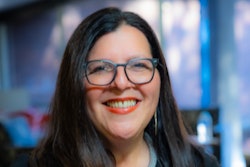Every five minutes, one Latinx person in America turns 18.
 Dr. Evans Igho Akpo
Dr. Evans Igho Akpo
“HSIs are educating the largest, youngest, and fastest-growing minority population in the U.S.,” said Akpo. “But they have a lower rate of graduation compared to other races, and the lack of educational attainment for Latinx students impacts the welfare of the country.”
In order to better serve Latinx students, Akpo said, institutions must self-reflect and perform their own internal studies. As the Latinx population continues to grow in the U.S., more Predominately White Institutions are transformed into HSIs, federally designated as serving a student population that is at least 25% Latinx. This turnover can be a time of institutional reflection.
“Institutions are influencers,” said Akpo. “Educational leaders must examine their institution’s legacy of inclusion or exclusion.”
The Latinx Success Institute surveyed 51 Latinx identifying students at a community college in Texas, all first-generation, and posed the question: what keeps you enrolled in school? The answers split four ways: peers, financial aid, mentors, and learning. Learning was by far the most common answer, chosen by more than half of participants.
“I thought about this,” said Akpo. “Of course, they came to learn. But it means that the institution needs to understand the student to create a learning strategy.”
Students said that their ability to persist is deeply impacted by friends and family, who they depend on for support, but not for the deep learning possible at a college or university.
Participants showed an “inherent desire to persist when they feel a sense of belonging, that they matter to their community,” said Akpo.
That sense of belonging can be facilitated through communication with college staff and faculty, special programs or events catering toward the Latinx experience. Akpo said that faculty and staff should be readily equipped with the knowledge of these events to remind their students, perhaps even make attendance worth a point on assessments. Opportunities for mentoring or tutoring Latinx students should be readily available and easily accessible.
 Rick Najera
Rick Najera
West, a professor at Union Theological Seminary, joined actor, writer and producer Rick Najera at Morton College in Cicero, Illinois. Together, they spoke about the shared experience of Latinx and Black populations and the tensions between the two communities, particularly in the Chicagoland area.
“This dialogue isn’t just Black and brown, brown and Black, intellectual smorgasbord. We are wrestling with our humanity,” said West, who is best known for his classic text Race Matters.
Holding conversations that recognize the divide between communities of color is deeply important, said Najera, to ending the “tribalism, my group as opposed to our group.”
“Our message is the message of inclusion,” he said. “What we’re doing here, keeping everyone together. We’re better together than apart.”
West added that “the quest for trust, beauty, and goodness shatters all forms of tribalism. Love, justice, integrity, and generosity cuts across the board.”
West and Najera called for courage to bring together communities, but West added that the media plays a crucial role. Instead of emphasizing moral exemplars, said West, the media often focuses on what generates a profit.
Najera said that art and theater can be the key to improving the relationship between communities of color.
“Arts bring us to a higher level," he said. "When you see theater, you experience other cultures and you become more compassionate.”
Latinos, he added, aren't monolithic.
“Latinos come in every size, shape and color,” said Najera. “We need to see our differences, applaud them, and learn from them.”
Najera noted that Chicago, which surrounds Cicero, is just tens of thousands of citizens away from becoming a majority Latinx city. Resolving Black and brown tension in Chicagoland, said West, can be done through bold and courageous actions, like when Latinx persons joined Black Lives Matter marches after the murder of George Floyd.
“We are marching against this murder because it’s wrong, it’s unjust. Whatever brown tensions are at work, whatever fears, we’ll bear witness,” said West.
Part of the experience of being a person of color in America, said Najera, is to question “who we are and why we are here. That sense of purpose is what this conversation is about.”
Liann Herder can be reached at [email protected].



















